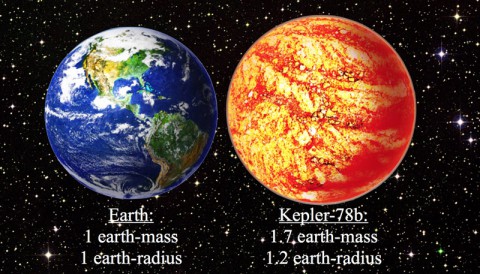Written by Whitney Clavin
NASA’s Jet Propulsion Laboratory
 Pasadena, CA – Astronomers have discovered the first Earth-size planet outside the solar system that has a rocky composition like that of Earth. Kepler-78b whizzes around its host star every 8.5 hours, making it a blazing inferno and not suitable for life as we know it. The results are published in two papers in the journal Nature.
Pasadena, CA – Astronomers have discovered the first Earth-size planet outside the solar system that has a rocky composition like that of Earth. Kepler-78b whizzes around its host star every 8.5 hours, making it a blazing inferno and not suitable for life as we know it. The results are published in two papers in the journal Nature.
“The news arrived in grand style with the message: ‘Kepler-10b has a baby brother,'” said Natalie Batalha, Kepler mission scientist at NASA’s Ames Research Center in Moffett Field, CA. Batalha led the team that discovered Kepler-10b, a larger but also rocky planet identified by NASA’s Kepler spacecraft.

Kepler-78b was discovered using data from NASA’s Kepler space telescope, which for four years simultaneously and continuously monitored more than 150,000 stars, looking for telltale dips in their brightness caused by crossing, or transiting, planets.
Two independent research teams then used ground-based telescopes to confirm and characterize Kepler-78b. To determine the planet’s mass, the teams employed the radial velocity method to measure how much the gravitational tug of an orbiting planet causes its star to wobble. Kepler, on the other hand, determines the size or radius of a planet by the amount of starlight blocked when it passes in front of its host star.

A handful of planets the size or mass of Earth have been discovered. Kepler-78b is the first to have both a measured mass and size. With both quantities known, scientists can calculate a density and determine what the planet is made of.
Kepler-78b is 1.2 times the size of Earth and 1.7 times more massive, resulting in a density that is the same as Earth’s. This suggests that Kepler-78b is also made primarily of rock and iron. Its star is slightly smaller and less massive than the sun and is located about 400 light-years from Earth in the constellation Cygnus.
One team, led by Andrew Howard from the University of Hawaii in Honolulu, made follow-up observations using the W. M. Keck Observatory on Mauna Kea in Hawaii. More information on their research can be found here.
This result will be one of many discussed next week at the second Kepler science conference November 4th to 8th at Ames. More than 400 astrophysicists from Australia, China, Europe, Latin America and the U.S. will convene to present their latest results using publicly accessible data from Kepler. More information about the conference can be found here.
Ames is responsible for Kepler’s ground system development, mission operations and science data analysis. JPL managed Kepler mission development. Ball Aerospace & Technologies Corp. in Boulder, CO, developed the Kepler flight system and supports mission operations with the Laboratory for Atmospheric and Space Physics at the University of Colorado in Boulder.
The Space Telescope Science Institute in Baltimore archives, hosts and distributes Kepler science data. Kepler is NASA’s 10th Discovery Mission and was funded by the agency’s Science Mission Directorate.
For more information about the Kepler mission, visit: http://www.nasa.gov/kepler and http://www.kepler.nasa.gov .


